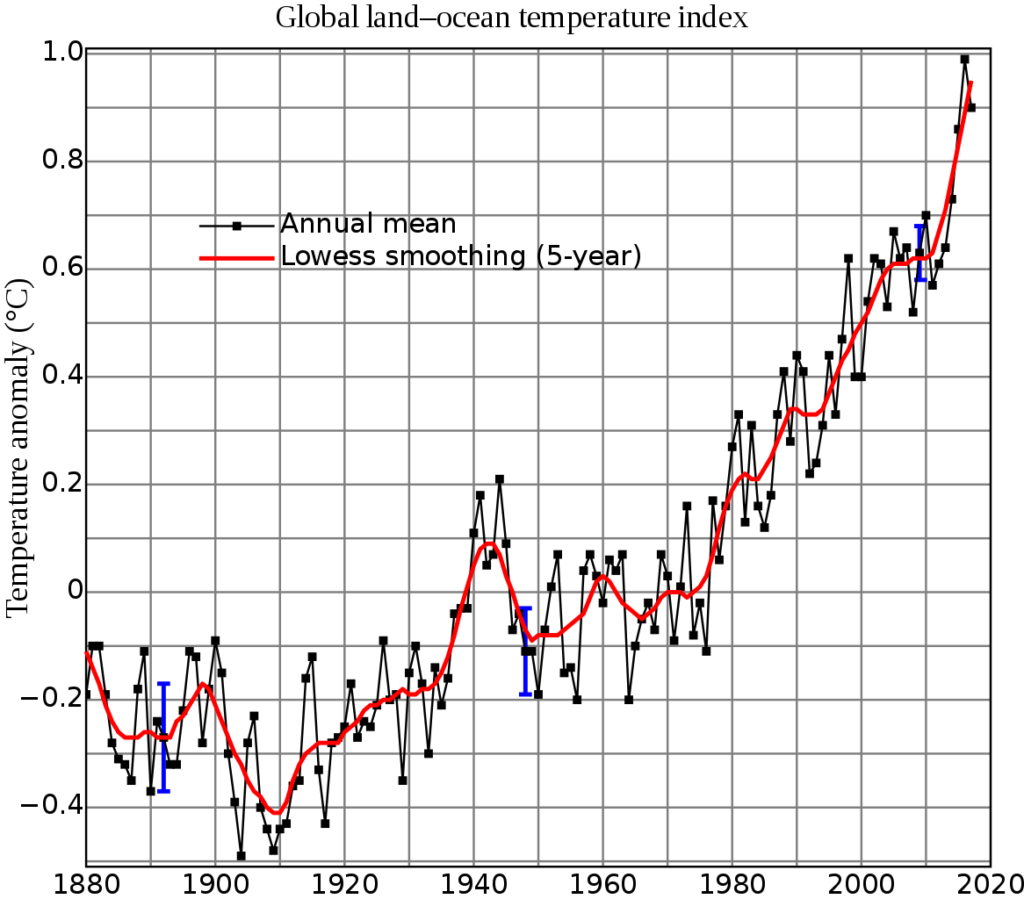A lot of people in my circles are skeptical about IPCC, probably as a general function of other insanity that these super-govt organizations tend to push. So I frequently hear stuff about how climate science can’t predict future correctly. The first IPCC (UN funded) report is from 1990 which gives us about 28 years since they were made, enough to get some idea of how well they have turned out. It makes the following predictions (as summarized by Wikipedia):
- We are certain of the following: there is a natural greenhouse effect…; emissions resulting from human activities are substantially increasing the atmospheric concentrations of the greenhouse gases: CO2, methane, CFCs and nitrous oxide. These increases will enhance the greenhouse effect, resulting on average in an additional warming of the Earth’s surface. The main greenhouse gas, water vapour, will increase in response to global warming and further enhance it.
- We calculate with confidence that: …CO2 has been responsible for over half the enhanced greenhouse effect; long-lived gases would require immediate reductions in emissions from human activities of over 60% to stabilise their concentrations at today’s levels…
- Based on current models, we predict: under [BAU] increase of global mean temperature during the [21st] century of about 0.3 oC per decade (with an uncertainty range of 0.2 to 0.5 oC per decade); this is greater than that seen over the past 10,000 years; under other … scenarios which assume progressively increasing levels of controls, rates of increase in global mean temperature of about 0.2 oC [to] about 0.1 oC per decade.
- There are many uncertainties in our predictions particularly with regard to the timing, magnitude and regional patterns of climate change, due to our incomplete understanding of: sources and sinks of GHGs; clouds; oceans; polar ice sheets.
- Our judgement is that: global mean surface air temperature has increased by 0.3 to 0.6 oC over the last 100 years…; The size of this warming is broadly consistent with predictions of climate models, but it is also of the same magnitude as natural climate variability. Thus the observed increase could be largely due to this natural variability; alternatively this variability and other human factors could have offset a still larger human-induced greenhouse warming. The unequivocal detection of the enhanced greenhouse effect is not likely for a decade or more.
- under the IPCC business as usual emissions scenario, an average rate of global mean sea level rise of about 6 cm per decade over the next century (with an uncertainty range of 3 – 10 cm per decade), mainly due to thermal expansion of the oceans and the melting of some land ice. The predicted rise is about 20 cm … by 2030, and 65 cm by the end of the next century.
I have bolded some values of interest. These are made under the assumption of business as usual (BAU), which I think it is fairly fair to say the world has largely followed. Action taken mostly reflects NW Euros building wind mills, some polar panels, and shutting down nuclear plants (partly in response to Fukushima event). Under that, what does the increase in mean temperature look like since 1990? We can derive quantitative predictions from their values (28 years since 1990), namely:
- Best guess of 2.8 * 0.3 = 0.84 C increase in temperature with range of 2.8 * 0.2 = 0.56 to 2.8 * 0.5 = 1.40.
- Best guess of 2.8 * 6 = 16.8 cm increase in sea level with range of 2.8 * 3 = 8.4 to 2.8 * 10 = 28.
https://en.wikipedia.org/wiki/Global_temperature_record#/media/File:Global_Temperature_Anomaly.svg
We can eyeball the change: 0.34 to 0.95 = 0.61. This is just above the lower bound of 0.56.
https://commons.wikimedia.org/wiki/File:NASA-Satellite-sea-level-rise-observations-1993-April-2018.jpg
Plot itself calculates the average which was 3.2 mm/year, compared with IPCC’s estimate of 6. We’re missing a bit of early 1990s here, but it’s good enough. The gain is slightly above the lower bound of 3.
Thus, both quantitative predictions since 1990 have been confirmed, but they are on the low side. One could try to argue that we have been doing more than BAU, but it doesn’t seem to me to be the case. One could maybe quantify this if they gave some kind of measure for what constitutes BAU.


I hope you’re taking some precautions about the choice of observational data, in regards to their regular re-re-re-vision. If those who made the predictions are also in charge of the observational data and its adjustments, there is opportunity for shenanigans.